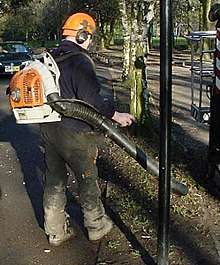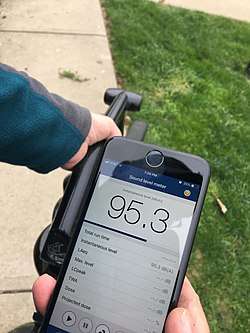Leaf blower

A leaf blower (often referred to as simply a blower) is a gardening tool that propels air out of a nozzle to move debris such as leaves and grass cuttings. Leaf blowers are powered by electric or gasoline motors. Gasoline models have traditionally been two-stroke engines, but four-stroke engines were recently introduced to partially address air pollution concerns. Leaf blowers are typically self-contained handheld units, or backpack mounted units with a handheld wand. The latter is more ergonomic for prolonged use. Larger units may rest on wheels and even use a motor for propulsion.[1] These are sometimes called "walk behind leaf blowers" because they must be pushed by hand to be operated.[2]
Some units can also suck in leaves and small twigs via a vacuum, and shred them into a bag. In that role it is called a blower vac.
Overview

The leaf blower was invented by Aldo Vandermolen in the 1950s. Drought conditions in California facilitated acceptance of the leaf blower as the use of water for many garden clean-up tasks was prohibited. Leaf blowers also save time compared to a broom.[3] By 1990, annual sales were over 800,000 in the U.S., and the tool had become a ubiquitous gardening implement.
Other functions beyond the simple use of garden maintenance have been demonstrated by Richard Hammond on the Brainiac television series, in which a man sized hovercraft was constructed from a leaf blower. Being both portable and able to generate wind speeds of between 140–270 miles per hour (63–121 m/s) and air volumes of 14 m3 per minute, the leaf blower has many potential uses in amateur construction projects. Some professional walk-behind leaf blowers can even reach air volumes of 100 m3 per minute (over 3800 CFM[4]).
Environmental and occupational impact

Emissions from gasoline-powered grounds-keeping equipment in general are a source of air pollution[5] and more immediately (when powered by internal combustion engines, rather than by electricity), noise pollution. In the United States, US emission standards prescribe maximum emissions from small engines.
In addition to the adverse health effects of carbon monoxide, nitrogen oxides, hydrocarbons, and particulates generated in the exhaust gas of the gasoline-powered engines, leaf blowers pose problems related to dust raised by the powerful flow of air. Dust clouds caused by leaf blowers contain potentially harmful substances such as pesticides, mold, and animal fecal matter that may cause irritation, allergies, and disease.
Noise pollution is also a concern with leaf blowers, as they emit noise levels well above those required to cause hearing loss to both the operator and those nearby.
Leaf blowers also present an occupational hearing hazard to the nearly 1 million people who work in lawn service and ground-keeping.[6] A recent study assessed the occupational noise exposure among groundskeepers at several North Carolina public universities and found noise levels from leaf blowers averaging 89 decibels (A-weighted) and maximum sound pressure levels reaching 106 dB(A), both far exceeding the National Institute for Occupational Safety and Health (NIOSH) Recommended Exposure Limit of 85 dB(A) [7]
Soon after the leaf blower was introduced into the U.S., its use was banned in two California cities, Carmel-by-the-Sea in 1975 and Beverly Hills in 1978, as a noise nuisance. There are currently twenty California cities that have banned leaf blowers, sometimes only within residential neighborhoods and usually targeting gasoline-powered equipment. Another 80 cities have ordinances on the books restricting either usage or noise level or both.[8]
See also
References
- ↑ "Leaf blowers". Consumer Reports. Retrieved 29 May 2014.
- ↑ Delulio, Joe. "Walk Behind Leaf Blower Buyer's Guide". Power Equipment Direct, Inc. Retrieved 29 May 2014.
- ↑ "CLCA Position On Leaf Blowers". California Landscape Contractors Association. Retrieved 29 May 2014.
- ↑ Performances of a walk-behind leaf blower leafblowerguide.com
- ↑ "Lawn Equipment | Improving Air Quality in Your Community | US EPA". Epa.gov. 2006-06-28. Archived from the original on 2009-04-28. Retrieved 2009-06-10.
- ↑ NIOSH (Jul 25, 2018). "Grounds for Change: Reducing Noise Exposure in Grounds Management Professionals". Retrieved Aug 15, 2018.
- ↑ Balanay, Jo Anne G.; Kearney, Gregory D.; Mannarino, Adam J. (2016-06-13). "Assessment of Occupational Noise Exposure among Groundskeepers in North Carolina Public Universities". Environmental Health Insights. 10: 83–92. doi:10.4137/EHI.S39682. ISSN 1178-6302. PMC 4909058. PMID 27330303.
- ↑ Leaf-blower regulations nationwide Consumer Reports magazine, September 2010.
External links
- "On Banning Leaf Blowers". The New York Times. 2017-03-17. Retrieved 2018-05-28.
- Cliff Weathers (2014). "Modern Pestilence: Leaf Blowers Generate Infuriating Noise, Toxic Gases and Hazardous Dust". Alternet. Retrieved 2018-05-28.
Blasting out air at hurricane-force speeds, leaf blowers spread allergens, toxins, pollutants and pathogens into the air we breathe
| Wikimedia Commons has media related to Leaf blowers. |